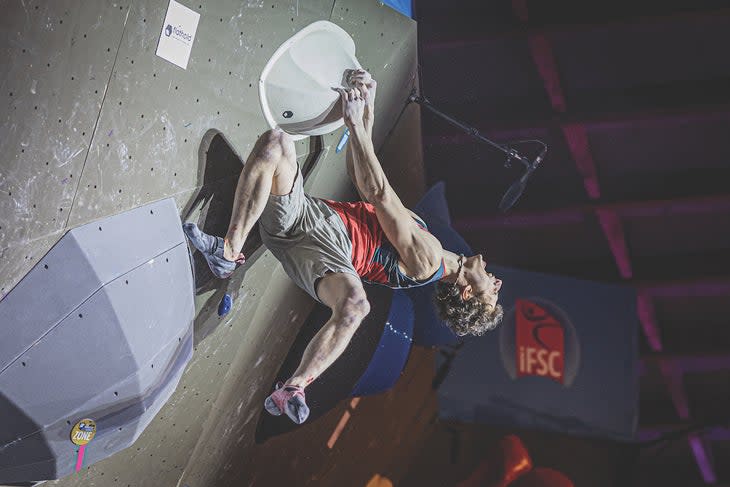It’s time to retire these 5 cliché climber quotes—now
Climbing
Earlier this year, I wrote about 10 "dumb" climbing terms we needed to retire for 2022. I still hear people--myself included--saying these things. It's a testament to how restrictive our lingo is that we fall back on even the most hackneyed climber slang. Maybe we just get tongue-tied at the wall when all the blood that should be feeding our brains gets trapped in our forearms because we haven't been ARCing lately.
Because I'm eternally grumpy (I live in a house with one wife, three kids, two cats, and one dog--it's as relaxing as a Norwegian death-metal concert), I've also found myself ruminating on climber quotes/sayings that drive me nuts. I've probably said ’em, you've probably said ’em, and we all know they're played, but we keep parroting these quotes anyway. It's like the awkward banter about the weather at the start of every Zoom meeting: We're powerless to stop ourselves because the silence is deafening; it's the hissing of the void.
Well, now here's our chance to get off the hamster wheel, at least with these five climber quotes. The sooner we stop saying them, the smarter we'll become--and I'll gladly tell you why.
1) “There is no too short, too tall, too heavy, too warm, too wet, or too humid. There is just one excuse: too weak.” --Alexander Megos
Megos said this in a 2016 interview at 8a.nu. He also, in the film Rotpunkt, which details his first ascent of Perfecto Mundo (5.15c) in Margalef, Spain, says, "There's no bad conditions. Only weakness," as he displays fingers ravaged by the route's pockets on a hot day. These quotes or some bastardized version of them seem to be the new go-to rebuttals--either self-directed or to chastise a climbing partner--every time a climber makes excuses for poor performance, especially one centered on conditions. But here's the thing: They're bullshit.
In the mid-1990s I lived in Turin, Italy, as part of a study-abroad program. There during a typically cold, foggy Italian winter, I took awhile to get plugged into the climbing scene. I finally found a good wall to train on, run by the local climber Marzio Nardi; it was at a fitness gym called Il Mondo. But Il Mondo was tiny, and the climbing area was sandwiched in behind the exercise bikes. One day I was making progress on a hard circuit, feeling pleased with myself. Then spin class started 10 feet away, a dozen fashionable, made-up Italian women pumping their legs and waving their hands around and panting and sweating and shit. Within minutes, it had become so steamy inside Il Mondo that I could no longer do the moves on the circuit.

So I ask you, Was I too weak? I was as strong at that moment as I was going to be at that moment; it was just that conditions had suddenly shifted, a stark example of how much they matter. So yes, you can always get stronger, but poor condies and other life factors (fitness, stress) will prevent you from optimizing your strength. Always. Dave Graham knows this; in fact, he's so all-in on optimizing condies that he has some dude follow him around Spain with a portable fan. (Take note, Megos!)
2) "The best climber in the world is the one having the most fun." --Alex Lowe
Alex Lowe, the late American legend known for his all-around rock and alpine prowess (big-wall first ascents, WI 6, A5, hard free and mixed climbs, etc.), was famously quoted as saying this. He'd been asked who the best climber in the world was for a profile article in this magazine. Lowe's quote was wonderful in the matter-of-fact way it captures why we should climb--focusing on process not outcome, soul not ego. It's a great reminder to lighten up and climb for the joy.
But here's the thing: Lowe, who died in 1999 in an avalanche on Shishapangma, never had a chance to meet the world's real, actual best climber. However, I did! I was in the Boulder Rock Club one morning in 2013 when two goobery, unathletic guys stumbled into the back, Expansion Room where I was auto-belaying, their rock shoes already donned and laced up. One guy had on tape gloves, even though there's only one crack at the gym and he wasn't climbing it. The moment three young women in yoga pants came into the room, he started throwing loud "dig-me" grunts as he flailed on some 5.6 birthday-party-kid, dinosaur-head-holds jug ladder, hoping they'd notice him. I don't think it worked, but this guy was still the world's best climber.
You know why? Because he was having the most fun (or, at least, he hoped to soon be...).
3)"He died doing what he loved." --Every climber at every climber funeral ever
Here's what we love about climbing: climbing. Here's what we don't love: injury and death. Nobody goes out climbing hoping or expecting to be maimed or killed, except maybe post-break-up 20-something males on angst-free-soloing benders or Eastern Bloc alpinists from the 1980s who had nothing to come home to except bread lines, drab, unheated apartment buildings, and being turned into the secret police for thought crimes by a vindictive neighbor. No, we go out climbing to embrace the fullness of life, and we do so with the expectation of coming home intact so we get to have this experience again.
This tired saying, by glossing over the real reason we climb, both cheapens our sport and minimizes the impact of losing a friend or loved one too soon in a climbing tragedy. Maybe better would be to say, "He died way too young, and it breaks my heart that this is sometimes the price we pay for our sport." To me, this seems more accurate.
4) "I bet Lynn Hill wouldn't call that move reachy; she'd just find another way to climb it." --Every average height or taller climber censuring a shorter partner complaining about being shut down on a stretchy crux
Usually it's some six-footer who reached right past the move spewing this old chestnut. And boy does it piss me off, even more than pimple-faced belay-test police and people who bring hammocks and vape pens to the crag (you know who you are). At 5'6" I have certainly found myself unable to do certain moves, or the moves were so stretchy and unpleasant that I didn't want to do them and risk injury. Height is a factor.
In the hopes of making this quote go away, I reached out to the reigning queen of American free climbing herself, Lynn Hill. At 5'1", Hill has certainly had to find creative beta solutions for her historic ascents (first woman to climb 5.14a, with Mass Critique in 1990; first free ascent of the Nose [VI 5.14a] in 1993). But there have also been reachy routes she decided weren't worth trying--yes, a few times, even Lynn Hill moved on. "One route is the La Rose et la Vampir (5.13d) at Buoux, France," she says. "I didn't think I could do the Rose move since it was awkward and a relatively far cross move. The other route that comes to mind is Verve (5.13c) in Boulder Canyon." (Both routes also have chipped/enhanced pockets at their cruxes, situated to suit taller climbers). Another stretchy climb was the arete Mango Tango (5.14a) at the New River Gorge, which she bolted with Scott Franklin (5'5"), who made its first ascent. "I think more strength would have helped for sure, but there was one move that I just couldn't do," says Hill.
Case closed!
5) "I bet Adam Ondra's grandkids could flash that!" --Every dim-bulb overstoker at the crag, while looking up at some blank, unclimbable wall.
Roger Bannister ran the world's first sub-four-minute mile in 1954, 68 years ago, at 3:59.4. The current world record is 3:43.13, ran by Hicham El Guerrouj in 1999. Guess what the current world record isn't? Two-minute miles run by Roger Bannister's grandchildren.
The same rules apply in climbing--I believe we are at or near the limits of human potential. The very best free climbers like Chris Sharma, Adam Ondra, Alex Megos, and Stefano Ghisolfi have moved the needle a little in the past decade, pushing the sport incrementally into 5.15c and 5.15d. But this has only been with concerted effort (read: campaigning) on a handful of climbs, aided by hyper-specific training. At a certain point, the rock gets too blank: You need holds, even if they're miniscule, to move upward. Everyone does, even these beasts who make quick work of 5.14 and lower-end 5.15.
So while I do think we'll see 10a/5.16a at some point, it's not going to be some blank face. Blank faces are for chipmunks, lizards, and spiders. Instead, it's going to be a longer, slightly tougher version of La Dura Dura (5.15c) or Silence (5.15d), with more and more difficult stacked cruxes that, as tough as they are, actually have handholds.
Matt Samet is a freelance writer and editor based in Boulder, Colorado. These days, his favorite climber saying is, "Can I stick-clip the third bolt for you?"

For exclusive access to all of our fitness, gear, adventure, and travel stories, plus discounts on trips, events, and gear, sign up for Outside+ today.]]>

